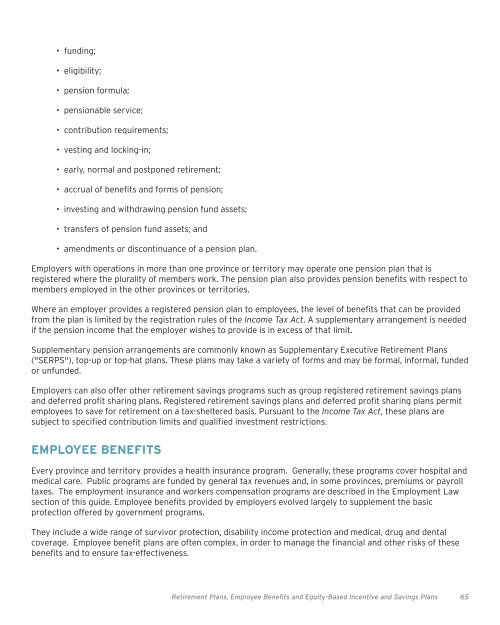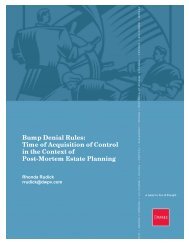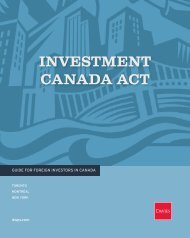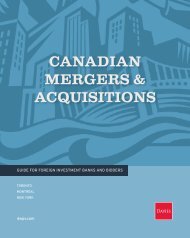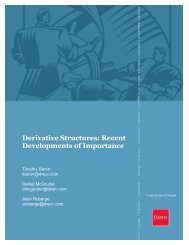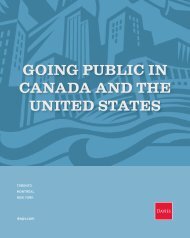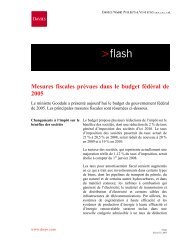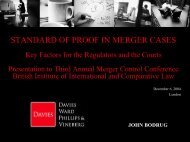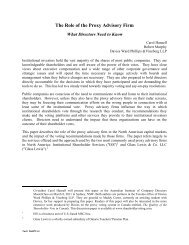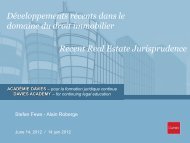doing business in canada - Davies Ward Phillips & Vineberg LLP
doing business in canada - Davies Ward Phillips & Vineberg LLP
doing business in canada - Davies Ward Phillips & Vineberg LLP
- No tags were found...
Create successful ePaper yourself
Turn your PDF publications into a flip-book with our unique Google optimized e-Paper software.
• fund<strong>in</strong>g;• eligibility;• pension formula;• pensionable service;• contribution requirements;• vest<strong>in</strong>g and lock<strong>in</strong>g-<strong>in</strong>;• early, normal and postponed retirement;• accrual of benefits and forms of pension;• <strong>in</strong>vest<strong>in</strong>g and withdraw<strong>in</strong>g pension fund assets;• transfers of pension fund assets; and• amendments or discont<strong>in</strong>uance of a pension plan.Employers with operations <strong>in</strong> more than one prov<strong>in</strong>ce or territory may operate one pension plan that isregistered where the plurality of members work. The pension plan also provides pension benefits with respect tomembers employed <strong>in</strong> the other prov<strong>in</strong>ces or territories.Where an employer provides a registered pension plan to employees, the level of benefits that can be providedfrom the plan is limited by the registration rules of the Income Tax Act. A supplementary arrangement is neededif the pension <strong>in</strong>come that the employer wishes to provide is <strong>in</strong> excess of that limit.Supplementary pension arrangements are commonly known as Supplementary Executive Retirement Plans("SERPS"), top-up or top-hat plans. These plans may take a variety of forms and may be formal, <strong>in</strong>formal, fundedor unfunded.Employers can also offer other retirement sav<strong>in</strong>gs programs such as group registered retirement sav<strong>in</strong>gs plansand deferred profit shar<strong>in</strong>g plans. Registered retirement sav<strong>in</strong>gs plans and deferred profit shar<strong>in</strong>g plans permitemployees to save for retirement on a tax-sheltered basis. Pursuant to the Income Tax Act, these plans aresubject to specified contribution limits and qualified <strong>in</strong>vestment restrictions.EMPLOYEE BENEFITSEvery prov<strong>in</strong>ce and territory provides a health <strong>in</strong>surance program. Generally, these programs cover hospital andmedical care. Public programs are funded by general tax revenues and, <strong>in</strong> some prov<strong>in</strong>ces, premiums or payrolltaxes. The employment <strong>in</strong>surance and workers compensation programs are described <strong>in</strong> the Employment Lawsection of this guide. Employee benefits provided by employers evolved largely to supplement the basicprotection offered by government programs.They <strong>in</strong>clude a wide range of survivor protection, disability <strong>in</strong>come protection and medical, drug and dentalcoverage. Employee benefit plans are often complex, <strong>in</strong> order to manage the f<strong>in</strong>ancial and other risks of thesebenefits and to ensure tax-effectiveness.Retirement Plans, Employee Benefits and Equity-Based Incentive and Sav<strong>in</strong>gs Plans 65


